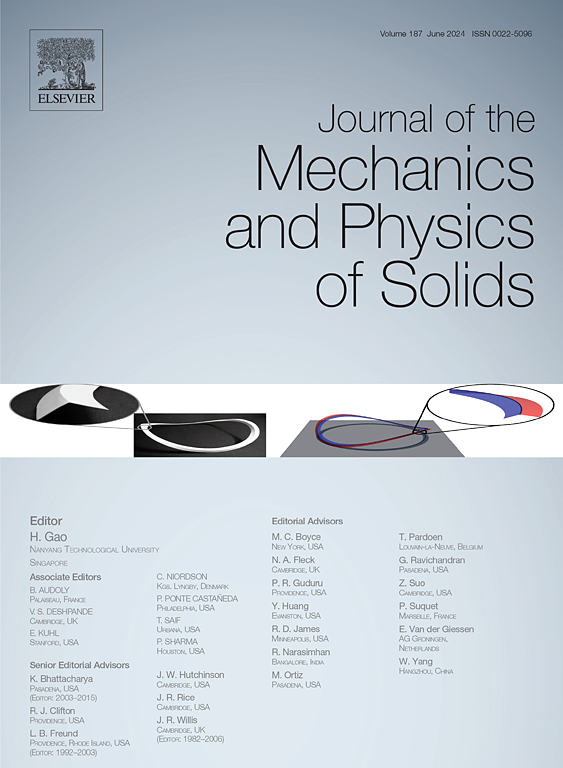具有复杂几何和拓扑结构的形状记忆聚合物束系统的变形模拟
IF 6
2区 工程技术
Q2 MATERIALS SCIENCE, MULTIDISCIPLINARY
引用次数: 0
摘要
我们提出了一种新的方法来分析由形状记忆聚合物制成的几何精确剪切变形梁系统。该方法将粘弹性广义Maxwell模型与Williams、Landel和Ferry松弛原理相结合,能够再现具有复杂几何和拓扑结构系统的形状记忆效应。利用等几何配置(IGA-C)方法对空间上的微分问题进行离散化,可以获得很高的效率。该方法除了具有等几何分析(IGA)的理想属性,如复杂形状几何重建的准确性和高阶精度外,还避免了数值积分的需要,因为它以强形式离散化了问题。所提出的公式的其他显著特征是:(i) SO(3)-问题线性化和时间步进的一致性;(ii)最小(有限)旋转参数化,这意味着只使用三个旋转未知数;(iii)与纯弹性情况相比,不需要额外的未知因素来解释速率相关材料。通过涉及具有挑战性的初始几何的不同数值应用,我们表明所提出的公式具有复杂系统的可编程性,几何灵活性和高阶精度方面的所有属性。本文章由计算机程序翻译,如有差异,请以英文原文为准。
Simulating morphing of shape memory polymer beam systems with complex geometry and topology
We propose a novel approach to the analysis of geometrically exact shear deformable beam systems made of shape memory polymers. The proposed method combines the viscoelastic Generalized Maxwell model with the Williams, Landel and Ferry relaxation principle, enabling the reproduction of the shape memory effect of structural systems featuring complex geometry and topology. Very high efficiency is pursued by discretizing the differential problem in space through the isogeometric collocation (IGA-C) method. The method, in addition to the desirable attributes of isogeometric analysis (IGA), such as exactness of the geometric reconstruction of complex shapes and high-order accuracy, circumvents the need for numerical integration since it discretizes the problem in the strong form. Other distinguishing features of the proposed formulation are: (i) -consistency for the linearization of the problem and for the time stepping; (ii) minimal (finite) rotation parametrization, that means only three rotational unknowns are used; (iii) no additional unknowns are needed to account for the rate-dependent material compared to the purely elastic case. Through different numerical applications involving challenging initial geometries, we show that the proposed formulation possesses all the sought attributes in terms of programmability of complex systems, geometric flexibility, and high order accuracy.
求助全文
通过发布文献求助,成功后即可免费获取论文全文。
去求助
来源期刊
CiteScore
9.80
自引率
9.40%
发文量
276
审稿时长
52 days
期刊介绍:
The aim of Journal of The Mechanics and Physics of Solids is to publish research of the highest quality and of lasting significance on the mechanics of solids. The scope is broad, from fundamental concepts in mechanics to the analysis of novel phenomena and applications. Solids are interpreted broadly to include both hard and soft materials as well as natural and synthetic structures. The approach can be theoretical, experimental or computational.This research activity sits within engineering science and the allied areas of applied mathematics, materials science, bio-mechanics, applied physics, and geophysics.
The Journal was founded in 1952 by Rodney Hill, who was its Editor-in-Chief until 1968. The topics of interest to the Journal evolve with developments in the subject but its basic ethos remains the same: to publish research of the highest quality relating to the mechanics of solids. Thus, emphasis is placed on the development of fundamental concepts of mechanics and novel applications of these concepts based on theoretical, experimental or computational approaches, drawing upon the various branches of engineering science and the allied areas within applied mathematics, materials science, structural engineering, applied physics, and geophysics.
The main purpose of the Journal is to foster scientific understanding of the processes of deformation and mechanical failure of all solid materials, both technological and natural, and the connections between these processes and their underlying physical mechanisms. In this sense, the content of the Journal should reflect the current state of the discipline in analysis, experimental observation, and numerical simulation. In the interest of achieving this goal, authors are encouraged to consider the significance of their contributions for the field of mechanics and the implications of their results, in addition to describing the details of their work.

 求助内容:
求助内容: 应助结果提醒方式:
应助结果提醒方式:


